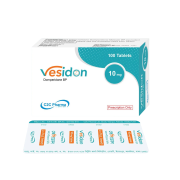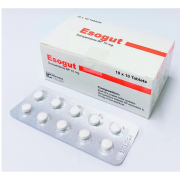Fixgut Oral Suspension
Domperidone Maleate
Indications
Dyspeptic symptom complex, often associated with delayed gastric emptying, gastroesophageal reflux and esophagitis:
- Epigastric sense of fullness, feeling of abdominal distension, upper abdominal pain
- Eructation, flatulence, early satiety
- Nausea and vomiting
- Heartburn with or without regurgitations of gastric contents in the mouth
- Non-ulcer dyspepsia
Acute nausea and vomiting of the functional, organic, infectious, dietetic origin or induced by radiotherapy or drug therapy or induced in migraine.
Parkinson’s disease: In dopamine-agonist induced nausea and vomiting.
Radiological studies: Speeding barium transit in follow-through radiological studies.
Pharmacology
Domperidone is a dopamine antagonist that principally blocks the dopamine receptors located in the ChemoreceptorTrigger Zone (CTZ) and stomach. Its gastroprokinetic action is based on its blocking effect of dopamine receptors that have an influence on the motility of the gastrointestinal tract. Due to its weak penetration across the blood-brain barrier, Domperidone has almost no effect on the dopaminergic receptors in the brain, therefore, excluding psychotropic and neurologic side effects. Domperidone restores normal motility and tone of the upper gastrointestinal tract, facilitates gastric emptying, enhances antral and duodenal peristalsis and regulates contraction of the pylorus. Domperidone also increases esophageal peristalsis and lower esophageal sphincter pressure, and thus prevents regurgitation of gastric content.
Dosage & Administration
Domperidone should be taken 15-30 minutes before meals and, if necessary, before retiring.
The usual recommended oral dose of Domperidone is as follows:
- Adults: 10-20 mg (1-2 tablet or 10-20 ml suspension), every 6-8 hours daily. The maximum dose of Domperidone is 80 mg daily.
- Children: 2-4 ml suspension/10 kg body weight or 0.4-0.8 ml paediatric drops/10 kg body weight, every 6-8 hours daily.
In dyspeptic symptom:
- Adults: 10-20 mg (1-2 tablet or 10-20 ml suspension), every 6-8 hours daily.
- Children: 0.2-0.4 mg/kg (2-4 ml suspension/10 kg or 0.4-0.8 ml paediatric drops/10 kg) body weight, every 6-8 hours daily.
In acute and sub-acute conditions (mainly in acute nausea and vomiting):
- Adults: 20 mg (2 tablets or 20 ml suspension), every 6-8 hours daily
- Children: 0.2-0.4 mg/kg (2-4 ml suspension/10 kg or 0.4-0.8 ml paediatric drops/10 kg) body weight, every 6-8 hours daily. (In acute nausea and vomiting maximum period of treatment is 12 weeks).
By rectum in suppositories:
- Adults (including elderly): 30-60 mg every 4-8 hours.
- Children: The maximum daily dose rectally in children’s is 30 mg for those weighting 10 to 25 kg. The dose may be divided throughout day if necessary.
- The maximum period of treatment is 12 weeks.
* চিকিৎসকের পরামর্শ মোতাবেক ঔষধ সেবন করুন‘
Interaction
Concomitant administration of anticholinergic drugs may antagonise the antidyspeptic effect of domperidone: Antacids and antisecretory drugs should not be given simultaneously with domperidone as they lower its oral bioavailability. The main metabolic pathway of domperidone is through CYP3A4. In vitro data suggest that the concomitant use of drugs that significantly inhibit this enzyme may result in increased plasma levels of domperidone. Examples of CYP3A4 inhibitors include: azole antifungals, macrolide antibiotics. HIV protease inhibitors, nefazodone, etc. Theoretically, since domperidone has gastro-kinetic effects it could influence the absorption of concomitantly orally administered drugs, particularly those with sustained release or enteric coated formulations. However, in patients already stabilised on digoxin or paracetamol, concomitant administration of domperidone did not influence the blood levels of these drugs.
- neuroleptics, the action of which it does not potentiate,
- dopaminergic agonists (bromocriptine, L-dopa), whose unwanted peripheral effects such as digestive disorders, nausea and vomiting it suppresses without counteracting their central properties.
Contraindications
Domperidone is contraindicated to patients having known hypersensitivity to this drug and in the case of neonates. Domperidone should not be used whenever gastrointestinal stimulation might be dangerous i.e., gastrointestinal hemorrhage, mechanical obstruction or perforation. Also contraindicated in patients with prolactin releasing pituitary tumor (prolactinoma).
Side Effects
Side-effects are rare; exceptionally some transient intestinal cramps have been reported. Extrapyramidal phenomena are rare in young children and exceptional in adults: they reverse spontaneously and completely as soon as the treatment is stopped. As the pituitary gland is located outside the blood-brain barrier, domperidone may induce an increase in the plasma prolactin level. In rare case this hyperprolactinaemia may give rise to neuroendocrinological phenomena such as galactorrhoea and gynaecomastia. When the blood-brain barrier is immature (as in infants) or impaired, the possible occurrence of neurological side-effects cannot be totally excluded. Rare allergic reactions, such as rash and urticaria, have also been reported.
Pregnancy & Lactation
Domperidone given to animals at doses up to 160 mg/kg/day did not produce teratogenic effects. However, as most medicines, domperidone should only be used during the first trimester of pregnancy if this is justified by the anticipated therapeutic benefit. Up to now, there has been no evidence of any increase in the risk of malformations in humans. The drug is excreted in breast milk of lactating rats. In women, domperidone concentrations in breast milk is 4 times lower than corresponding plasma concentrations. It is not known whether this is harmful to the newborn. Therefore nursing is not recommended for mothers who are taking domperidone, unless the expected benefits outweigh any potential risk. Effects on ability to drive and use machines: Domperidone does not affect the mental alertness.
Precautions & Warnings
Fixgut should be used with absolute caution in the case of children because there may be an increased risk of extra-pyramidal reactions in young children because of an incompletely developed blood-brain barrier. Since domperidone is highly metabolized in liver, it should be used with caution in patient with hepatic impairment.
Use in Special Populations
Use in infants: Because the metabolic and blood-brain barrier functions are not fully developed during the first months of life, any drug should only be given to infants with great caution and under close medical supervision. Since the typical absence of neurological side effects with domperidone is mainly due to its poor penetration through the blood-brain barrier, the possible occurrence of such effects cannot be totally excluded in infants under 1 year of age. Use in liver disorders: Since domperidone is highly metabolised in the liver, domperidone should be used with caution in patients with hepatic impairment. Use in kidney disorders: In patients with severe renal insufficiency (serum creatinine >6 mg/100ml, i.e. >O.6 mmol/I) the elimination half-life of domperidone as increased from 7.4 to 20.8 hours, but plasma drug levels were lower than in healthy volunteers. Since very little unchanged drug is excreted via the kidneys, it is unlikely that the dose of a single acute administration needs to be adjusted in patients with renal insufficiency. However, on repeated administration, the dosing frequency should be reduced to once or twice daily, depending on the severity of the impairment, and the dose may need to be reduced. Generally, patients on prolonged therapy should be reviewed regularly.
Overdose Effects
Symptoms of overdosage may include drowsiness, disorientation and extrapyramidal reactions, especially in children. In case of overdosage, the administration of activated charcoal, and close observation of the patients are recommended. Anticholinergic, antiparkinson drugs or antihistamines with anticholinergic properties may be helpful in controlling the extrapyramidal reactions.
Therapeutic Class
Motility Stimulants, Motility stimulants/Dopamine antagonist, Prokinetic drugs
Storage Conditions
Store below 30°C, Protected from light & moisture. Keep out of children’s reach.
Chemical Structure
| Molecular Formula : | C22H24ClN5O2 |
| Chemical Structure : |
Common Questions about Fixgut 5 mg/5 ml Suspension
What is Fixgut 5 mg/5 ml Suspension used for?
Fixgut 5 mg/5 ml Suspension is a dopamine antagonist medication which is used to treat nausea and vomiting.
Quick Tips
- Fixgut 5 mg/5 ml Suspension helps relieve nausea, vomiting and indigestion.
- Fixgut 5 mg/5 ml Suspension should be taken before meals as per the dose and duration prescribed by your doctor.
- Fixgut 5 mg/5 ml Suspension may cause dizziness and sleepiness. Do not drive or do anything that requires mental focus until you know how it affects you.
- Avoid consuming alcohol when taking Fixgut 5 mg/5 ml Suspension as it may cause excessive drowsiness.
- Dry mouth may occur as a side effect. Frequent mouth rinses, good oral hygiene, increased water intake and sugarless candy may help.
- Inform your doctor if you get watery diarrhea, fever, or stomach pain that does not go away.
- Do not take Fixgut 5 mg/5 ml Suspension for longer than 7 days without consulting your doctor.


